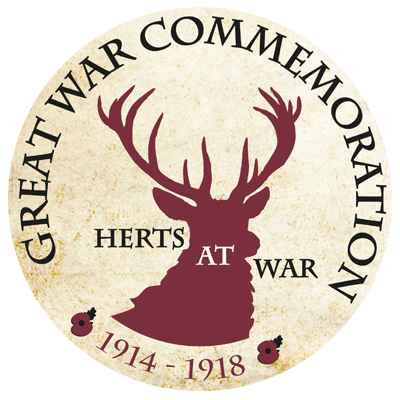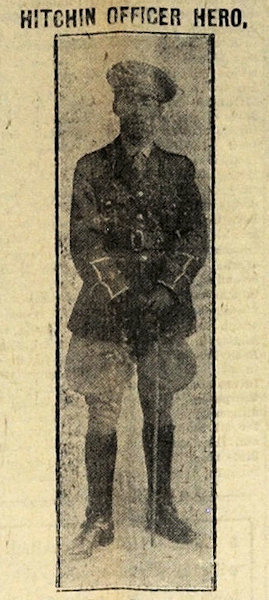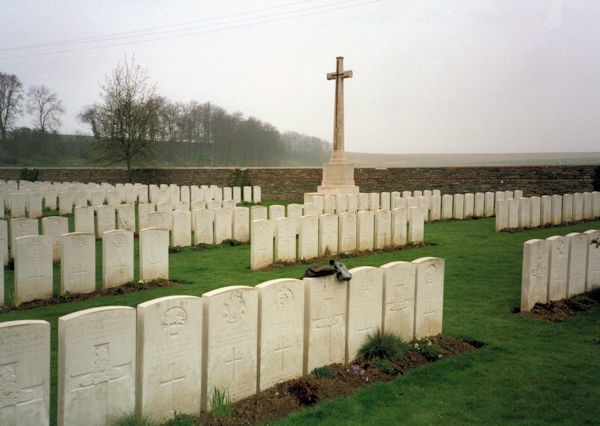Name
Raymond Cecil Robinson
Circa 1896
Conflict
First World War
Date of Death / Age
19/10/1918
22
Rank, Service Number & Service Details
Second Lieutenant
Royal Garrison Artillery
270th Siege Battery
Awards: Service Medals/Honour Awards
British War and Victory medals
Cemetery/Memorial: Name/Reference/Country
VADENCOURT BRITISH CEMETERY, MAISSEMY
II. C. 27.
France
Headstone Inscription
Not Researched
UK & Other Memorials
Hitchin Town Memorial, St Mary's Church Roll of Honour (Book), Hitchin
Pre War
Wartime Service
He was Private in 2/2 Coy Sussex Royal Garrison Artillery, rising first to Acting Corporal and, commissioned on 4 February 1918 becoming Second Lieutenant in the 270th Siege Battery, Royal Garrison Artillery and went to France in April 1918.
A newspaper article recorded that “His efficiency and smartness quickly brought him promotion from the ranks.”
The Battery was equipped with 6" howitzers and for the Battle of the Selle formed part of the 98th Brigade Royal Garrison Artillery of 9 Corps in the 4th Army. The battle commenced on the 17th October 1918 which was wet and misty. A tremendous barrage was let loose with great belts of fire leapfrogging forward to assist the infantry attacks.
Nine Corps started roughly halfway between Peronne and Bohain in the area where Ray was to be buried a few days later. By the evening of the 19th October, 9 Corps had reached the line of the Sambre Canal with the German defence in a state of near collapse.
He was badly wounded in the knee with a large shell splinter on 19 October 1918 and was take to the No. 5 Casualty Clearing Station by Motor ambulance.
He was almost certainly wounded in one of the constant duels between the British and German Artillery units.
The matron of the hospital to which he was admitted wrote that “He arrived seriously wounded on October 19 and he died 5 minutes later.”
After his death two officers wrote to his family:
Captain McKay wrote: “It is with deepest sympathy and regret that I write and inform you of the death of your very dear son Raymond. He was wounded in the leg on the afternoon of October 19 and died the same evening in hospital. The last I saw of the dear boy was to put him into an ambulance. He looked then fairly strong, very cheery and very brave. It was a terrible shock to myself and his brother officers when we received the sad news from hospital the following morning. Raymond was loved by both officers and men. He always showed such marked courage and utter disregard for personal danger. He was an exceedingly efficient and gallant officer, and whatever task was laid for him to do he always came out on top with flying colours. He leaves a big blank in the Battery. Raymond was a great friend of mine personally. I will miss him most dreadfully: he was such a dear affectionate fellow; he would have done anything for me and I would have done the same for him, poor laddie . . . . The major will be very cut up when he hears from me. I could write reams to the brave boy’s credit. I closed by saying that I am very, very proud to have the honour to be the dear Raymond’s Battery Commander. I know this will be a great shock and grief to you all, but try to look upon it from the beautiful side Raymond made the great sacrifice and died a hero, and no man can do more. I am sure he will be happier than any of us to-day.”
Lieut. H. J. Bretton, a fellow officer, wrote “During my period of 18 months with 270 (Siege Battery) I can emphatically say that Raymond was the most cheerful and willing officer that we have ever had; always the first to volunteer and the last to give in. His loss is already most acutely felt by both officers and men; he was a great favourite with us all and was most competent with all branches of the Service.
Raymond was wound in knee with rather a large shell splinter while carrying out his duties. It was a great surprise for us to hear the same evening that poor Raymond had died of wounds at No. 5 Casualty Clearing Station at 7:45 PM. I last saw him leaving the battery in a motor ambulance. He seemed most cheerful, and did not appear to be in much pain.
All the officers wish me to send their most tender sympathies, and may it please God to soon bring this terrible war to a successful ending.”
He is buried in Plot 2 Row C Grave 27 in the Vadencourt British Cemetery, Maissemy in France.
Additional Information
His pension records show his mother, Hephzibah Robinson of Fairfield Lodge, Benslow Lane, Hitchin, was awarded £20 per annum, and first £5 issued 20 October 1918. During the assessment, her private income was noted as £103 2s 8d.
His elder brothers both served; Alfred was a driver in the Army Service Corps attached to the field ambulance – going to France in 1915 and William (Jack) was a gunner in the Anti-Aircraft section who went to France in 1917.
An in Memoriam for Raymond was placed in the Hertfordshire Express on Saturday 18 October 1919 by his father, mother, brother and sisters.
Acknowledgments
Adrian Dunne, David C Baines, Jonty Wild



